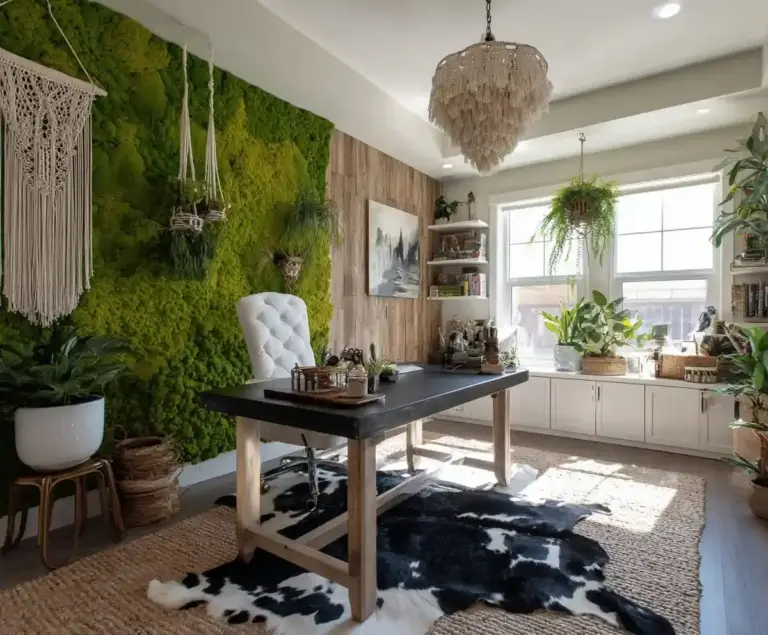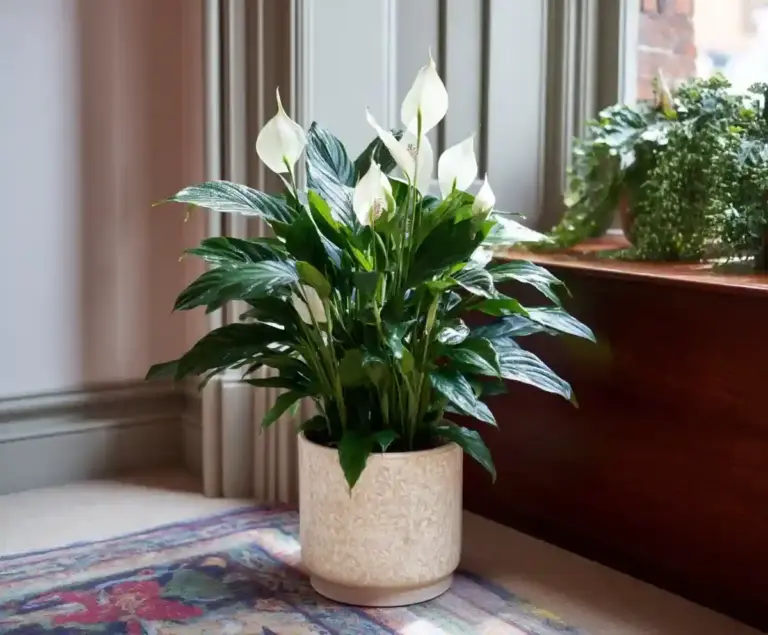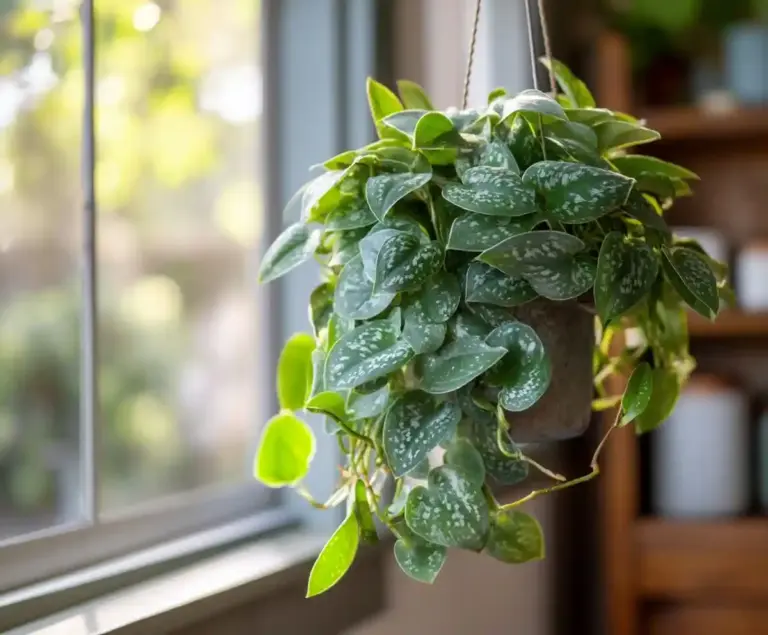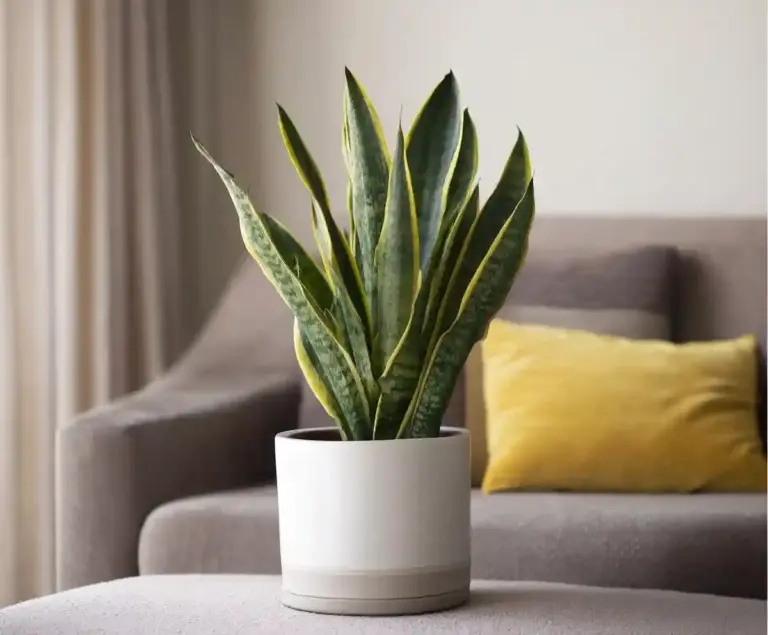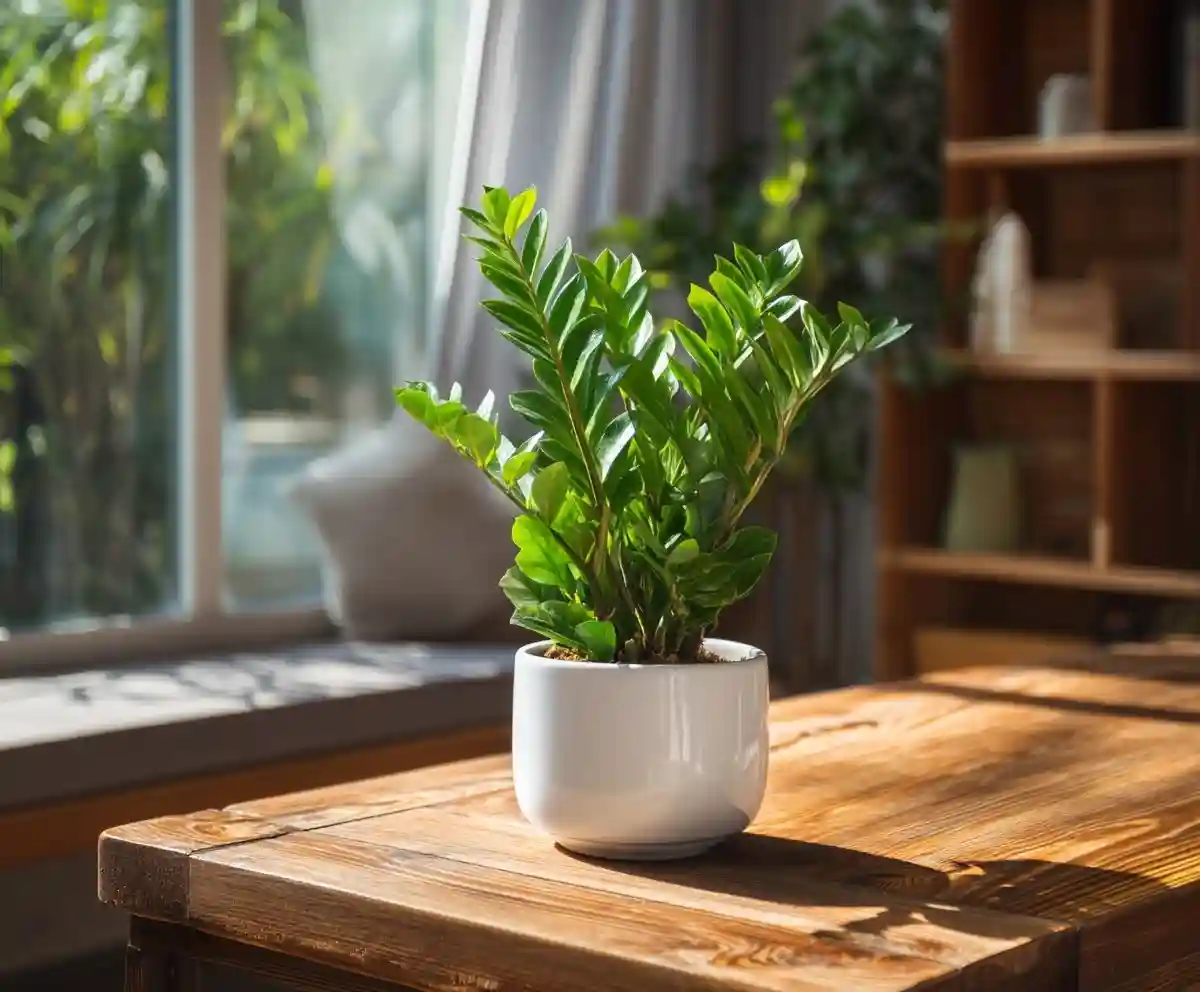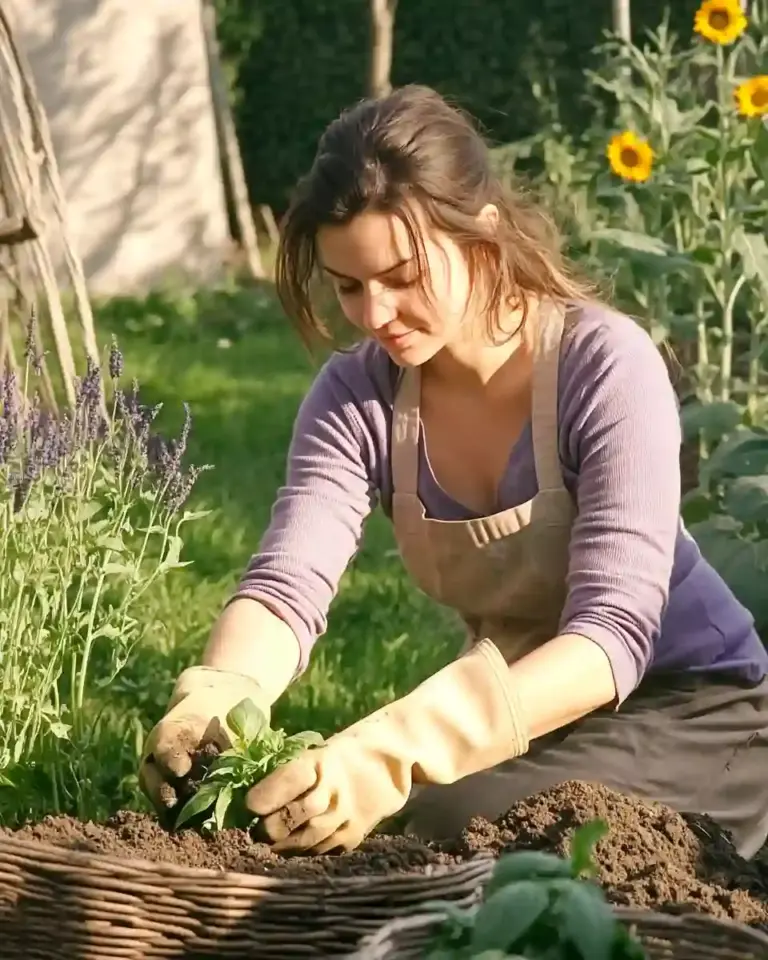ZZ Plant is one of the easiest houseplants you’ll ever grow. With its glossy green leaves and incredible ability to thrive on neglect, the ZZ Plant (Zamioculcas zamiifolia) has earned a place in homes and offices worldwide. Whether your windows face north or you tend to forget your watering can for weeks, this tough tropical beauty can still flourish.
Native to Eastern Africa, the ZZ Plant grows slowly but steadily, reaching up to 2–4 feet tall. It handles low-light conditions, prefers well-draining soil, and requires minimal watering—making it ideal for beginners or anyone wanting a low-maintenance indoor plant. Its thick rhizomes store water, helping the plant survive dry spells, while its deep green leaves add a sculptural elegance to any room.
However, keep in mind: all parts of the ZZ Plant are toxic if ingested and may cause skin irritation. Always wash hands after handling or wear gloves, especially when pruning or repotting.
Table of Contents
🌱 Quick Care Facts
| Botanical Name | Zamioculcas zamiifolia |
|---|---|
| Common Names | ZZ Plant, Zanzibar Gem, Eternity Plant |
| Mature Size | 2–4 ft. tall and wide |
| Light | Low to bright indirect |
| Soil Type | Well-draining potting mix |
| Soil pH | 6.0–7.0 (slightly acidic to neutral) |
| Bloom Time | Rare indoors; small white to yellow flowers near base |
| Hardiness Zones | USDA 9–10 (outdoors) |
| Toxicity | Toxic to pets and humans if ingested |
🪴 How to Grow ZZ Plants
Light
ZZ Plants are exceptionally tolerant of low-light conditions, which is part of what makes them so beloved. While they can survive in dim corners or windowless offices, they truly thrive in bright, indirect light. Giving your ZZ Plant at least a couple of hours of filtered sunlight daily will help maintain its compact, upright growth and lush green foliage.
Avoid placing your plant in direct sunlight, which can scorch its waxy leaves. A north or east-facing window is ideal. If you notice leggy stems or slower growth, your plant may be asking for a bit more light.
Soil
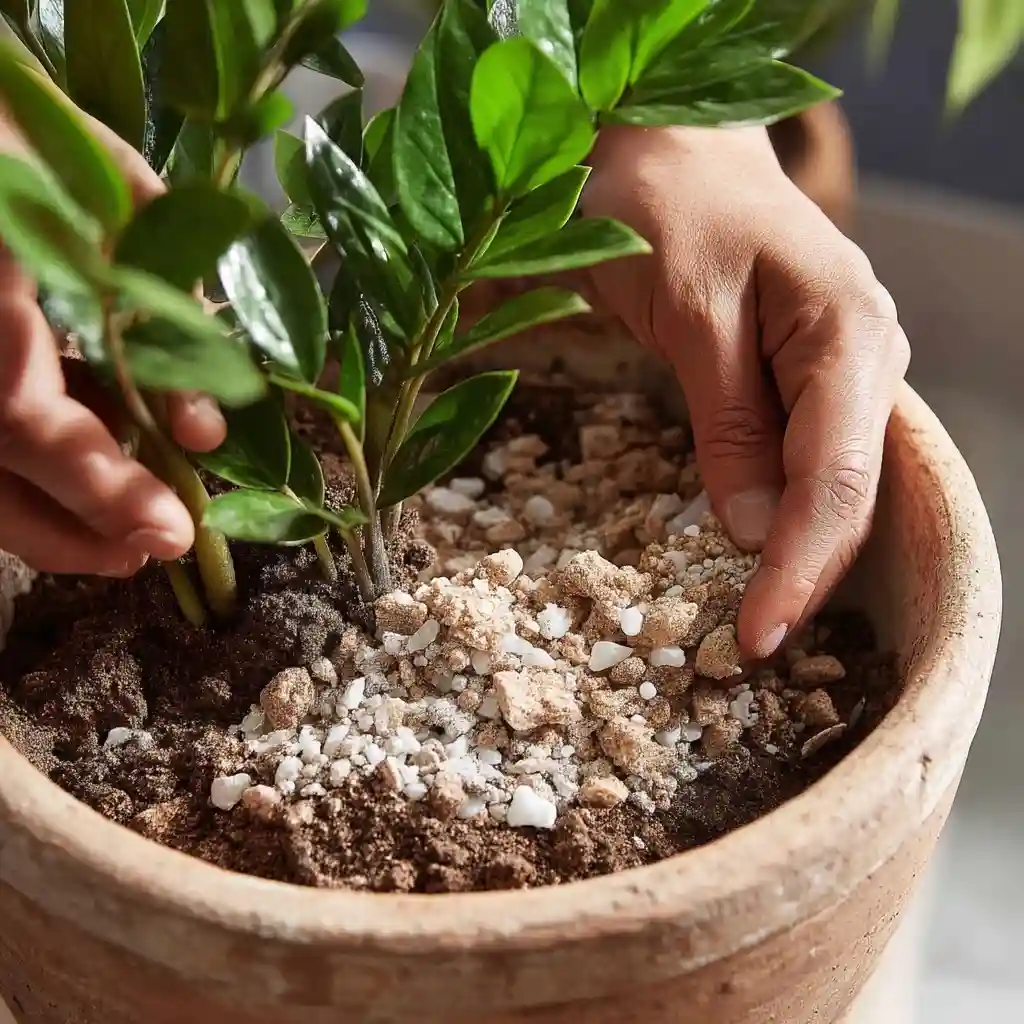
The best soil for a ZZ Plant is a well-draining, lightweight houseplant mix. Because its rhizomes hold moisture, overly dense or water-retentive soil can easily lead to root rot.
To improve drainage, consider mixing in perlite or orchid bark. Choose a soil with a pH between 6.0 and 7.0, which provides the slight acidity this plant prefers.
💡 Pro Tip: Never let your ZZ Plant sit in soggy soil. A breathable pot and fast-draining mix will prevent the most common issues.
Water
Watering ZZ Plants is delightfully low-stress. These plants are drought-tolerant and prefer to dry out completely between waterings. On average, watering once every 2–3 weeks is sufficient, but always adjust based on your environment.
In winter, ZZ Plants require even less water. Watch for yellowing leaves or mushy stems, both signs of overwatering. It’s far safer to underwater than to risk soggy soil.
Use the “finger test”: stick your finger 2 inches into the soil—if it’s dry, it’s time to water thoroughly.
Temperature & Humidity
The ZZ Plant is adapted to average indoor conditions and doesn’t require tropical humidity or constant misting. It does best in temperatures between 65–75°F (18–24°C), but can handle a bit warmer.
However, it’s very sensitive to cold. Temperatures below 45°F (7°C) can cause leaf damage or even kill the plant. Keep it away from cold drafts, air conditioning vents, or open windows during winter.
If your home is especially dry during the colder months, occasional misting or a nearby humidity tray can be beneficial, but isn’t essential.
Fertilizer
ZZ Plants don’t need much in the way of feeding. For optimal growth, apply a balanced, water-soluble houseplant fertilizer diluted to half strength once or twice during the growing season (spring through early fall).
Avoid overfertilizing—too much can lead to salt buildup in the soil, which harms roots. If your plant looks healthy and is putting out new growth, you may skip fertilizing altogether.
🌿 Varieties of ZZ Plants
While the classic ZZ Plant is instantly recognizable for its rich green, glossy leaves, there are a few unique cultivars that bring exciting variations to this already stylish plant. These varieties share the same low-maintenance care requirements but differ in color and visual appeal.
🖤 ZZ Plant ‘Raven’
The ‘Raven’ ZZ Plant is a striking cultivar that starts out with bright green leaves which mature to a deep purple-black shade. This dramatic transformation makes ‘Raven’ a favorite among collectors and modern interior designers.
- Foliage Color: Bright green when young, then turns glossy black
- Light Needs: Same as standard ZZ, but better color development with moderate indirect light
- Unique Feature: Color-darkening effect adds visual interest
🎨 Variegated ZZ Plant
The Variegated ZZ Plant is much rarer and known for its marbled foliage, blending green with white or creamy yellow patterns. This type requires more light than others to maintain its variegation.
- Foliage Color: Green leaves streaked with white or yellow
- Light Needs: Needs bright, indirect light (or filtered sunlight) to retain variegation
- Care Tip: In low light, variegation may fade and revert to solid green
🪴 Note: All ZZ Plant varieties share the same care principles—just adjust lighting based on foliage color needs.
✂️ Pruning ZZ Plant

Pruning a ZZ Plant isn’t required often, but a little maintenance now and then helps keep it looking full and healthy. The goal is to remove any leggy, yellowing, or aging stems and to encourage a bushier, more compact growth habit.
When to Prune
- Spring and summer are ideal times, during the plant’s active growth phase.
- Prune as needed when stems grow too tall or sparse, or when leaves start to fade.
How to Prune Properly
- Use clean, sharp pruning shears or scissors.
- Trim stems at a 45° angle just above a leaf node to encourage new shoots.
- For fuller shape, cut back the tallest stems slightly shorter than the rest.
- Remove older leaves at the base when they turn yellow or wilt naturally.
💡 Pro Tip: Don’t discard healthy cuttings—you can use them for propagation (which we’ll cover next!).
Why Pruning Matters
- Prevents legginess caused by low light
- Maintains attractive shape
- Removes dead or diseased parts
- Encourages new growth
🌱 Propagating ZZ Plant
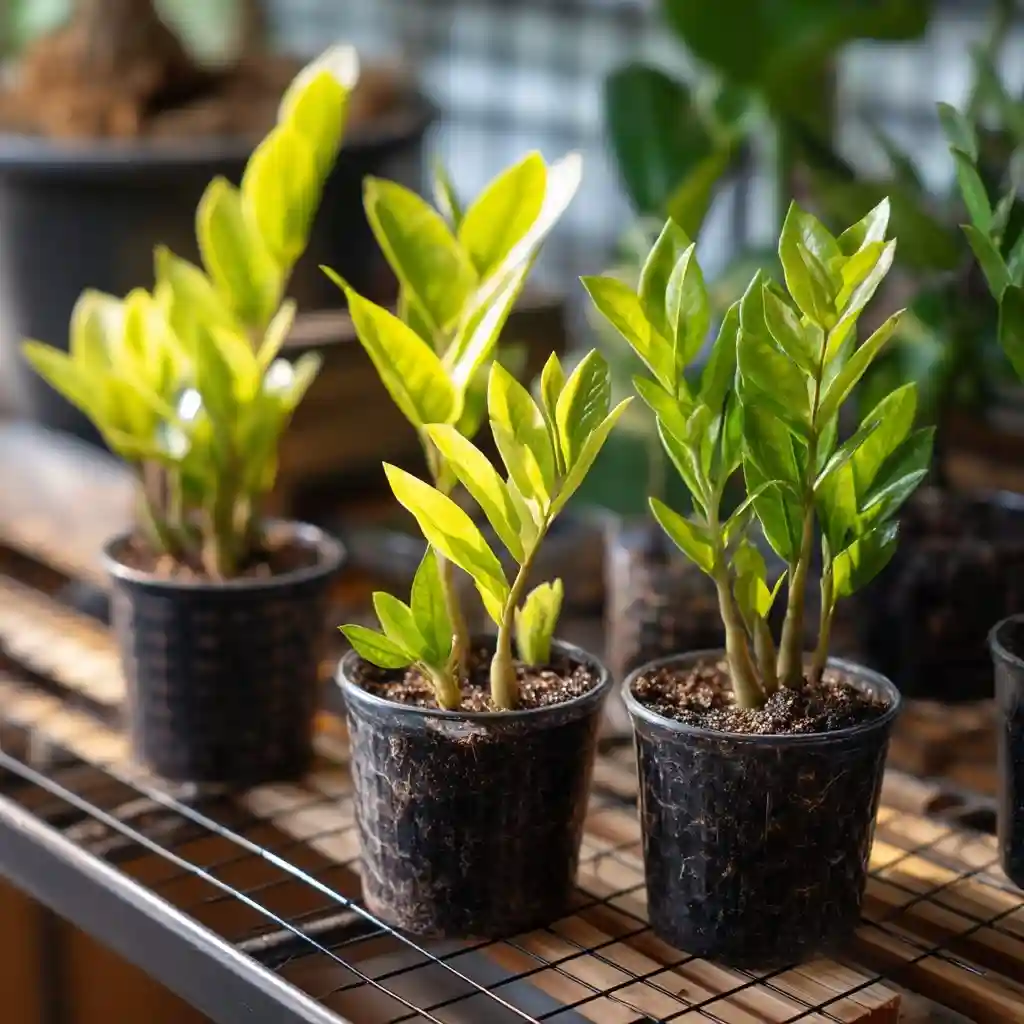
The ZZ Plant is as easy to propagate as it is to grow. Whether you’re multiplying your collection or gifting to friends, you can propagate this plant by division or cuttings. Both methods are simple, though leaf and stem cuttings require a bit more patience.
Division (Best for Quick Results)
Division is the easiest and fastest way to propagate a ZZ Plant. It’s best done when repotting a mature plant with multiple rhizomes.
Steps:
- Gently remove the plant from its pot.
- Brush away excess soil to expose the thick rhizomes (underground storage structures).
- Carefully pull apart the clumps, ensuring each section has roots and at least one stem.
- Repot each new division into fresh, well-draining soil and water lightly.
🧤 Tip: Wear gloves—ZZ sap can cause skin irritation.
Leaf or Stem Cuttings (Slow but Rewarding)
This method is perfect if you only have one plant and don’t want to divide it.
For Leaf Cuttings:
- Use a clean knife to remove a mature leaf from the plant.
- Let it callous over for a day.
- Plant the base of the leaf in moist, well-draining soil.
- Place in bright, indirect light and keep the soil barely moist.
For Stem Cuttings:
- Take a section of stem with at least two leaves attached.
- Let the cut end dry for 24 hours.
- Insert it into soil and water gently.
Be patient! It may take 6–9 months for cuttings to develop rhizomes and produce visible new growth.
🪴 Potting & Repotting ZZ Plant
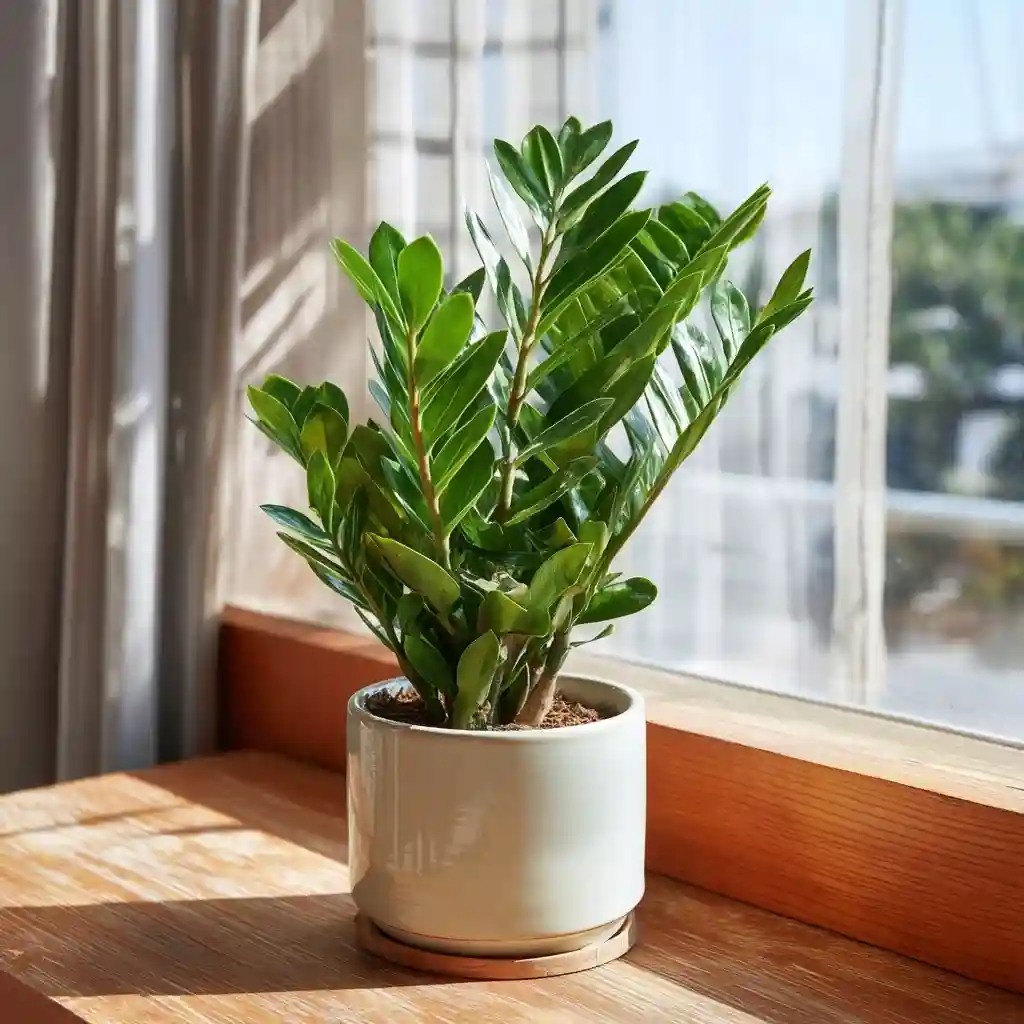
ZZ Plants prefer being slightly root-bound, so frequent repotting isn’t necessary. However, when the roots or rhizomes begin pressing against the pot edges—or you notice slowed growth—it’s time to upgrade the container.
When to Repot
- Every 2–3 years, or when roots begin to circle the bottom of the pot
- When rhizomes bulge or distort the container shape
- Best done in spring or summer to minimize transplant shock
How to Repot
- Choose a pot one size larger than the current one, with good drainage.
- Gently remove the ZZ Plant and shake off excess soil.
- Trim away any rotting or damaged roots, if present.
- Fill the new pot with fresh, well-draining potting mix and place the plant at the same depth.
- Water lightly after potting to settle the soil.
Optional: Divide While Repotting
If the plant is very large, you can divide it into two or more separate plants during repotting (see previous section on propagation).
Safety Note
The sap of ZZ Plants can irritate skin, especially if you have sensitivities. Always wear gloves when handling rhizomes, pruning, or repotting.
🧽 Keep the leaves clean post-repotting by wiping with a damp cloth—dust can block light absorption and dull their natural shine.
.
🐛 Common Pests & Plant Diseases
Although the ZZ Plant is known for being tough and relatively pest-free, it’s not completely immune. With proper care and observation, you can easily keep your plant healthy and thriving.
Common Pests
While uncommon, a ZZ Plant can occasionally attract standard indoor plant pests, especially if stressed by overwatering or low airflow.
Watch for:
- Mealybugs – White, cottony patches near stem joints
- Scale – Brown or tan bumps along stems and leaves
- Fungus Gnats – Small black flies near the soil surface
- Aphids – Small green or black bugs clustered on new growth
Treatment:
- Remove pests with a damp cloth or cotton swab dipped in isopropyl alcohol
- Use insecticidal soap or neem oil spray every 7–10 days for persistent infestations
- Let soil fully dry to deter fungus gnats
🌬️ Tip: Improve air circulation and avoid overwatering to reduce pest risks.
Common Diseases
Most diseases affecting ZZ Plants are caused by overwatering, leading to fungal or bacterial infections.
Symptoms:
- Yellowing leaves
- Soft, mushy stems
- Brown spots with yellow halos
- Water-soaked lesions on leaves
What to Do:
- Isolate affected plant immediately
- Allow soil to dry out completely
- Trim away affected leaves or stems
- Apply a fungicide if signs of rot persist
🚫 Avoid using heavy, moisture-retaining soil or pots without drainage holes—it’s the #1 cause of ZZ plant disease.
⚠️ Common Problems With ZZ Plant
While ZZ Plants are famously low-maintenance, a few problems can pop up—especially if lighting, watering, or temperature conditions aren’t ideal. Recognizing the early signs helps you correct issues before they become serious.
1. Leggy or Sparse Growth
Cause: Too little light
Symptoms: Long, stretched-out stems; fewer leaves per stem
Fix: Move your plant to a spot with more indirect sunlight—at least 2 hours per day. Rotate the pot occasionally to encourage even growth.
2. Yellow Leaves
Cause: Overwatering
Symptoms: Lower leaves turn yellow and mushy; root rot may be present
Fix: Let soil dry out completely. Remove damaged leaves and repot if root rot is suspected. In the future, reduce watering frequency.
🟡 Note: Occasional yellowing of older, lower leaves is normal as the plant grows.
3. Wrinkled or Drooping Leaves
Cause: Underwatering
Symptoms: Leaves appear shriveled or curl downward
Fix: Give your plant a thorough watering and adjust your routine to prevent prolonged drought. While ZZ Plants tolerate dry conditions, they still need hydration now and then.
4. Brown Tips or Edges
Cause: Dry indoor air or inconsistent watering
Symptoms: Leaf tips turn brown or crispy
Fix: Avoid placing near heaters or air vents. Maintain consistent watering and consider increasing humidity slightly in winter.
5. Slow or No Growth
Cause: Insufficient light or nutrients
Fix: Move to a brighter area and consider applying diluted fertilizer once or twice during the growing season.
❓ FAQ: ZZ Plant Care Questions
1. Where should I place my ZZ Plant in the home?
Place your ZZ Plant in a spot that receives bright, indirect light—such as near an east- or north-facing window. It can survive in low-light areas, but growth may slow and become leggy without adequate light.
2. Can I touch a ZZ Plant?
Yes, you can touch and handle a ZZ Plant, but take precautions. Its sap can cause skin irritation, especially in sensitive individuals. Wear gloves when pruning, propagating, or repotting. Always wash your hands after handling.
3. How long does a ZZ Plant live?
With proper care, a ZZ Plant can live for 20 years or more. Its slow growth and resilience make it one of the most durable indoor plants available.
4. Is the ZZ Plant toxic to pets or children?
Yes. All parts of the ZZ Plant are toxic if ingested by humans or animals. Keep it out of reach of pets and small children. Symptoms may include vomiting, irritation, or other digestive issues.
5. What type of pot is best for a ZZ Plant?
Choose a pot with drainage holes to prevent root rot. The plant isn’t picky about pot depth but prefers one that accommodates its expanding rhizomes without becoming too compacted.
6. Why is my ZZ Plant not growing?
Slow growth is normal, especially in low light or cooler seasons. However, if your plant hasn’t produced any new stems in months, check for poor lighting, overwatering, or root congestion. You may need to repot or relocate it.
✅ Conclusion
The ZZ Plant is one of the most reliable and forgiving houseplants you can grow. With its sculptural beauty, tolerance to neglect, and ability to thrive in low light, it’s the perfect addition to homes, offices, and apartments alike. Whether you’re a complete beginner or a seasoned plant lover, the ZZ Plant delivers longevity and style with minimal effort.
Just remember the basics: give it well-draining soil, let it dry out between waterings, keep it away from cold drafts, and provide some indirect light. In return, this plant will reward you with years—if not decades—of lush, green growth.
🌿 Love gardening inspiration? Follow me on Pinterest for bold plant ideas, tips, and seasonal color!
More Posts
